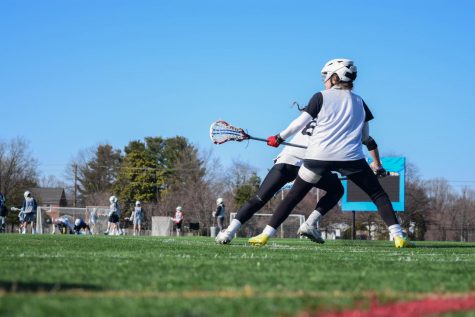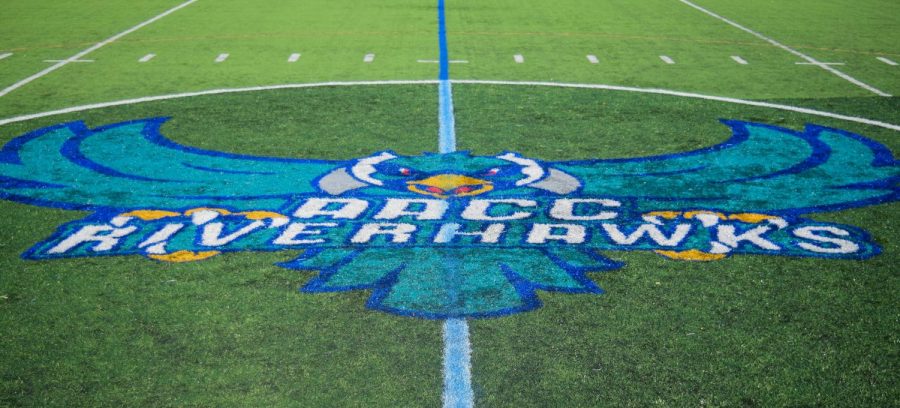MD lawmakers debate turf field health risks
Some groups claim the ingredients in artificial turf like that in AACC’s Siegert Stadium are unhealthy for athletes and the environment. Manufacturers disagree.
April 1, 2018
State legislators may decide synthetic turf, like the kind on AACC’s Siegert Stadium field, is too dangerous to play on.
Maryland lawmakers are debating whether the chemicals in synthetic turf make it unsafe for athletes and the environment. They are considering a bill that would stop schools and recreation centers in the state from using government funds to build or replace sports fields or playgrounds with turf made of artificial materials like rubber, plastic or recycled tires.
AACC has used synthetic turf in its stadium since 2010 when the college built it.
Synthetic turf is on sports fields and playgrounds all over the country. Manufacturers have promoted it as durable and easy to maintain, but some question the safety of its ingredients.
The black rubber beads that make the turf bouncy and support the plastic grass-like blades are made of pulverized tires. According to the Sierra Club—a national environmental advocacy organization—tire rubber is a mix of synthetic and natural rubber, petroleum and other chemicals that are known to cause cancer in humans.
“[Tires] can’t even be stored in landfills,” said Ginger Macomber, senior assistant to Del. Aruna Miller, D-Montgomery County. “Tires and other plastics indisputably include alarming contents like lead, mercury, 11 known human carcinogens [and] others.”

Lawmakers may decide not to pay for synthetic turf on school fields because of health concerns.
There is no scientific consensus as to whether contact with synthetic turf actually causes cancer.
Still, the Centers for Disease Control and Prevention has shown that turf, if not properly sanitized, may transfer staph infections to athletes who play on it.
Interim Athletics Director Keith Bigelow said AACC has sanitized its synthetic field twice in the last eight years, most recently last summer. In addition, the turf field gets a monthly grooming.
“We have had no incidents of infections reported from the turf,” said Bigelow. “I think if we saw that there was a reason to do it more often, then we would. … Our players’ and our student athletes’ safety is our No. 1 focus.”
The Maryland Chapter of the Sierra Club suggests natural grass playing fields.
But although it is less expensive to install a natural field, annual maintenance costs are higher: about $30,000 compared with $4,000, according to the Maryland legislation.
AACC athletes said they aren’t concerned with getting staph infections and said they weren’t aware that any of the materials in the turf may be harmful.
“You can get staph from the turf, I heard, but I didn’t know there were any other health risks,” said first-year soccer player Isaiah Goodman.
Second-year Men’s Lacrosse captain Dylan Morton said he did not know turf made from crushed tires carried health risks.
“I’ve played sports almost my whole life, and I’ve never heard about that,” he said.
If state legislators pass House Bill 505 and Senate Bill 763, the law would take effect July 1 and would affect any project for which money has not yet been allocated by the state.













Dr. Zuckerman • Apr 11, 2018 at 12:48 AM
Crumb rubber and other synthetic turf fields and playgrounds have real health risks that are being ignored: in addition to head injuries and turf burns, the materials can affect hormones and thereby cause early puberty, obesity, Attention Deficit Disorder, and eventually cause cancer. They can exacerbate asthma and cause eye and skin irritations. Why would anyone pay $1 million plus for that? See http://www.center4research.org/children-athletes-play-toxic-turf-playgrounds/ for more info. I’m going to be testifying about it at the Consumer Product Safety Commission tomorrow.
Tireles DC • Apr 1, 2018 at 11:11 PM
The MRSA risks are well-known l An American University athlete sent in photos and testimony to the House and State hearings . She contracted an infection as a direct result of a turf burn and ended up with necrotizing fasciitis, a flesh eating infection, which almost resulted in a leg amputation.
Keith Bigelow, we are very surprised you are not aware of the many collegiate teams with rampant staph issues related to synthetic turf. The New York Times and other outlets have covered it. Just go to Twitter and search #mrsa and #turf and you’ll see many instances.
Your field has been sanitized two times in eight years?! That’s a lot of blood, spit, sweat, vomit, animal feces and urine sitting on there.